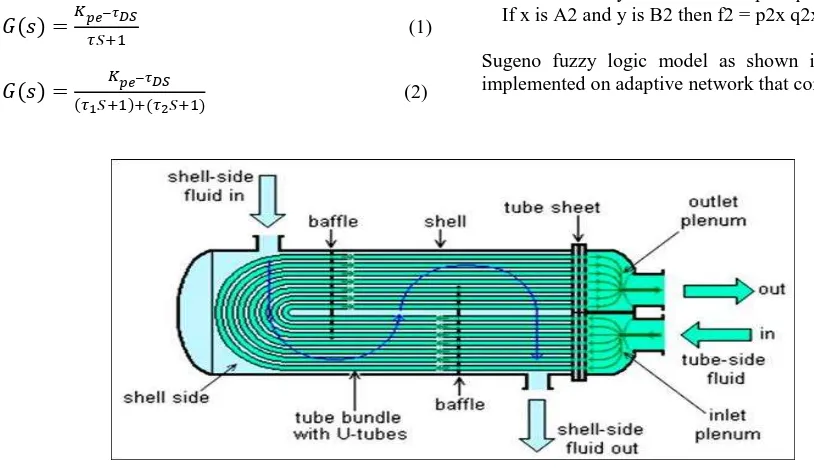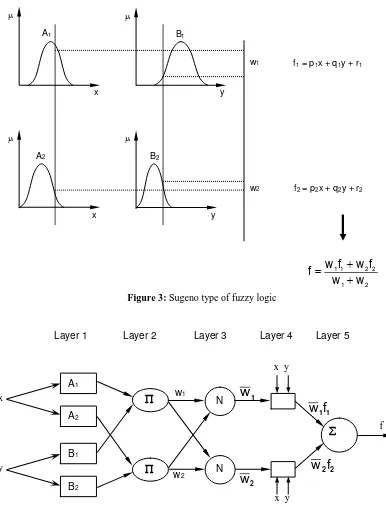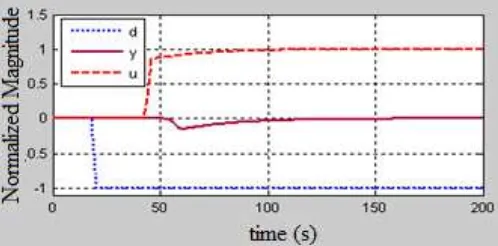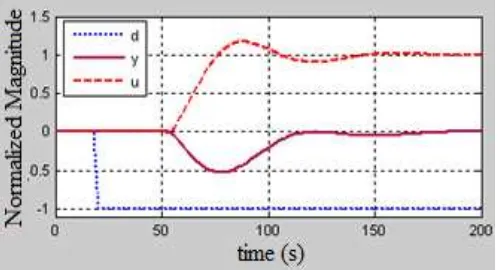Heat Exchanger Control Based on Artificial Intelligence Approach
Agus Jamal1and Ramadoni Syahputra2
1Department of Electrical Engineering, Faculty of Engineering, Universitas Muhammadiyah Yogyakarta, Yogyakarta, 55183, Indonesia .
E-mail: agusjamalumy@gmail.com
2Department of Electrical Engineering, Faculty of Engineering, Universitas Muhammadiyah Yogyakarta, Yogyakarta, 55183, Indonesia.
E-mail: ramadoni@umy.ac.id
Abstract
This paper presents a model of the heat exchanger temperature control using artificial intelligence approach. Artificial intelligence based controllers used in this study is a fuzzy logic controller. Heat exchanger is a device used to perform the process of mixing a fluid having a different temperature. In this case the temperature control becomes very important. Fuzzy logic control is applied to the heat exchanger so that the mixed fluid having a constant temperature. Model of fuzzy logic control in this study combined with neural network techniques. Fuzzy logic controller models are simulated in Matlab software. The results show that the control of the fuzzy logic controller capable of stabilizing the temperature of the heat exchangers well.
Keywords: Artificial Intelligence, Fuzzy Logic Controller, Heat Exchanger, Temperature Controller.
INTRODUCTION
Application of artificial intelligence-based techniques in the control system has become an important issue in the last two decades. One technique based on artificial intelligence are widely used in the control system is a fuzzy logic techniques [1]-[5]. Fuzzy logic is a development of the primitive logic that is only recognizes two states, namely "yes" or "no". With the fuzzy logic, it can recognize linguistic variables like rather large, large, very large, and so forth. Thus, the application of fuzzy logic will lead to more adaptive system [6]-[11].
Controlling temperature is an important process in the industry such as light bulbs, the dairy industry, the pharmaceutical industry, incubators, and others. During this time the temperature control is still using the on-off switch manually [12]-[16]. This research attempts to simulate the use of neuro-fuzzy method, which is often also known by the method of Adaptive Neuro Fuzzy Inference System to control the temperature in the heat exchanger.
This study aims to learn more in-depth method of neuro-fuzzy through networking concepts and adaptive inference systems fuzzy logic, and create a software-simulated control the temperature of the heat exchanger at the reactor clams using neuro-fuzzy, which developed in the software of Matlab-Simulink. The main contribution of this study is to the world of education and research community or another (industry, banking, and companies) that have a great interest or interest, directly or indirectly. More concretely, the contribution is that by using the model to be made in this research, users can learn
concepts and workings of Neuro Fuzzy on intelligent systems, especially in the temperature control problem [17]. Another contribution is that by overcoming the problem of temperature control heat exchanger in chemical reactors, the production process errors can be minimized so as to increase the productivity of industries for example the dairy industry, lights, and medicine .
The use of the method in the field of neuro-fuzzy control has been widely used. Control methods by applying the principles of fuzzy logic called FLC (fuzzy logic controller) [18]-[19]. How it works is similar to the control of an operator control, do not pay attention to the internal structure of the plant, just observe set-point error as the difference between the system outputs and change the control panel settings to minimize the error [19]-[22]. An FLC consists of defuzzification unit, fuzzy knowledge base, and fuzzy decision engine. Application of the neural-network in solving various problems that are controlling the system of which have been successfully carried out in [23] which makes artificial neural network and fuzzy system to control of power flow, and in the [24] that suggests the artificial neural network with fuzzy approach for control of PSS.
medicine, and others. In this process the expected is that the fluid that has been in a tank when mixed with new fluid input, then the total fluid in the tank must quickly reach a desired temperature.
Figure 1 shows the typical of a heat exchanger while the control scheme of a heat exchanger is shown in Figure 2. For cases where the available media hot liquid, such as water, the required heat exchanger with high efficiency. To design a controller in the heat exchanger, the exact mathematical model of the process is determined. Most of the industrial system of non-linear in its application can be approximated as a first order system with the added time delay (first order plus time delay, FOPTD) or models of the second order plus time delay (second order plus time delay, SOPTD). The general shape and SOPTD FOPTD models can be expressed respectively in equation (1) and equation (2) as follows:
� � =
���−�����+1 (1)
� � =
���−���� �+1 + � �+1 (2)
Fuzzy Logic Control System
Neuro-Fuzzy parameters are separated into two parameters: parameter of premise and parameter of consequences. The adaptation process is done in order to obtain these parameters in order to form an adaptive network that represents the desired inference systems. The search process parameters and parameter premise consequences are often known as learning or training process. The training process for Neuro-Fuzzy used in this research that back propagation (propagation) and hybrid (combined propagation and least squares estimation, LSE).
Neuro-Fuzzy architecture depends on the type inference system to be implemented. As an example of fuzzy logic
inference systems first order Sugeno’s type with two inputs
and two rules as follows, as shown in Figure 3. If x is A1 and y is B1 then f1 = p1x q1x + r1 If x is A2 and y is B2 then f2 = p2x q2x + r2
Sugeno fuzzy logic model as shown in Figure 4 can be implemented on adaptive network that consists of five layers.
Figure 1: Typical of a heat exchanger
Figure 3: Sugeno type of fuzzy logic
Figure 4: Neuro-fuzzy architecture of Sugeno type
METHODOLOGY
Model design of intelligent systems for controlling the temperature of the heat exchanger as a process can be seen in Figure 5. This study used a closed loop control scheme. Controllers used are based controllers neuro-fuzzy adaptive. Based control scheme in Figure 5, we then implemented in software Matlab as shown in Figure 6.
Figure 5: Control scheme of a heat exchanger
A1
A2
B1
B2
x
y
N
N
f
x y
x y 2
w
1
w
w1
w2
1 1
f
w
2 2
f
w
Layer 1 Layer 2 Layer 3 Layer 4 Layer 5
A1
A2
B1
B2 x
x
y
y
w1
w2
f1 = p1x + q1y + r1
f2 = p2x + q2y + r2
2 1
2 2 1 1
w
w
f
w
f
w
f
Figure 6: Control scheme of a heat exchanger as a process in Matlab environment
RESULTS AND DISCUSSION
Model of Heat Exchanger Temperature Control
Heat exchanger temperature control model in this study were made in Matlab software is shown in Figure 7.
Figure 7: Model of temperature control of heat exchanger
In Figure 7, it appears that in general the GUI (Graphical User Interface) consists of three components, namely:
1) Model temperature control system, 2) Diagram transfer function, and 3) Graph feedback control results.
Open Loop Control Model
In this simulation test the temperature of the heat exchanger system without a controller, as shown in Figure 8. Shown in the graph in Figure 8 that the response of the system is very bad, which are indicated by the signal response of the system (y) deviate from the reference signal (u).
Figure 8: Model system without controlling the temperature of heat exchanger
Feedforward Control Model
In this simulation, testing of temperature in the heat exchanger system with feedforward controller types is done, as shown in Figure 9. Shown in the graph in Figure 9 shows that the response system is already delivering results that are slightly better than without a controller, which is characterized by a system response signal (u) already approaching the reference signal (y), which takes 45 seconds to get up to the magnitude of the desired temperature (i.e. 1), and finally achieved his 100th sec.
Feedback Control Model
In this simulation, testing of temperature in the heat exchanger system to control what type of feedback is done, as shown in Figure 10. As shown in the graph in Figure 10 that the feedback system is already delivering results that are slightly better than without controllers, although relatively worse than feedforward controllers. This is indicated by the signal response of the system (u) is approaching the reference signal (y), which takes 55 seconds to get up to the magnitude of the desired temperature (i.e. 1). Furthermore, oscillation occurs until the second-to-150 to reach temperature stability. In the application of this control overshoot as high as 20% of the magnitude of the expected temperatures, although only occur in a relatively short time span of 25 seconds to lead a stable condition. Response result this type of feedback control is relatively slow compared to the response of the feedforward control, since feedback control work that always have to evaluate every previous output in the loop so computationally relatively longer than the feedforward controller.
Figure 10: Model of heat exchanger temperature system with controllers Feedback
Feedback and Feedforward Controls
In this simulation, testing of temperature control in the heat exchanger system with combined type feedforward control and feedback is shown in Figure 11. As shown in the graph of Figure 11, it can be seen that the feedback system is already delivering results that are slightly better than the results with previous controllers. This is indicated by the signal response of the system (u) is approaching the reference signal (y), which takes 45 seconds to get up to the magnitude of the desired temperature (i.e. 1). Furthermore, oscillation occurs until the second-to-120 to reach temperature stability at a desired magnitude is 1. In the application of this control overshoot as high as 20% of the magnitude of the expected temperatures, although only occur in a relatively short time span of 20 seconds to lead a stable condition, Response results combined feedforward and feedback control is relatively fast compared to the response of feedback control, because the work is not purely feedback controllers always have to evaluate each of the previous output in the loop. Thus the computation required is relatively shorter than the feedback controller.
Figure 11: Model of temperature heat exchanger system with a combined controller Feedforward and Feedback
CONCLUSION
In this study conducted a simulation test system temperature in the heat exchanger with the type of feedforward controllers, control the results obtained are relatively better compared with feedback control, especially in the speed of response to the situation stable. This is due to the feedforward control requires computational load is relatively small compared with the feedback control.
In the simulation with a combined feedforward and feedback control, found that the system response is already giving results that are slightly better than results with feedforward control and feedback control. This is evident from the 45 seconds it takes to rise to the magnitude of the desired temperature. The next time of oscillating were relatively minor and lasted for a short time to get to a state of stability which is 20 second.
REFERENCES
[1] Syahputra, R., Robandi, I., Ashari, M. (2014). Optimization of Distribution Network Configuration with Integration of Distributed Energy Resources Using Extended Fuzzy Multi-objective Method. International Review of Electrical Engineering (IREE), 9(3), pp. 629-639.
[2] Syahputra, R., Soesanti, I., Ashari, M. (2016). Performance Enhancement of Distribution Network with DG Integration Using Modified PSO Algorithm. Journal of Electrical Systems (JES), 12(1), pp. 1-19. [3] Syahputra, R., (2012), “Fuzzy Multi-Objective
Approach for the Improvement of Distribution
Network Efficiency by Considering DG”, International
Journal of Computer Science & Information Technology (IJCSIT), Vol. 4, No. 2, pp. 57-68. [4] Syahputra, R., (2012), “Distributed Generation: State
of the Arts dalam Penyediaan Energi Listrik”, LP3M UMY, Yogyakarta, 2012.
[5] Syahputra, R., Robandi, I., Ashari, M. (2014).
“Optimal Distribution Network Reconfiguration with Penetration of Distributed Energy Resources”,
Information Technology, Computer, and Electrical Engineering (ICITACEE) 2014, UNDIP Semarang, pp. 388 - 393.
[6] Syahputra, R., Robandi, I., Ashari, M., (2012),
“Reconfiguration of Distribution Network with DG
Using Fuzzy Multi-objective Method”, International Conference on Innovation, Management and Technology Research (ICIMTR), May 21-22, 2012, Melacca, Malaysia.
[7] Syahputra, R., Robandi, I., Ashari, M., (2011),
“Modeling and Simulation of Wind Energy Conversion System in Distributed Generation Units”. International
Seminar on Applied Technology, Science and Arts (APTECS). 2011; pp. 290-296.
[8] Syahputra, R., Robandi, I., Ashari, M., (2011), “Control of Doubly-Fed Induction Generator in Distributed Generation Units Using Adaptive Neuro-Fuzzy
Approach”. International Seminar on Applied
Technology, Science and Arts (APTECS). 2011; pp. 493-501.
[9] Utomo, A.T., Syahputra, R., Iswanto, (2011),
“Implementasi Mikrokontroller Sebagai Pengukur Suhu Delapan Ruangan”, Jurnal Teknologi, 4(2).
[10] Soedibyo, Ashari, M., Syahputra, R. (2014), Power loss reduction strategy of distribution network with distributed generator integration. 1st International Conference on Information Technology, Computer, and Electrical Engineering (ICITACEE) 2014, UNDIP Semarang, pp. 404 – 408.
[11] Syahputra, R. (2016). Application of Neuro-Fuzzy Method for Prediction of Vehicle Fuel Consumption. Journal of Theoretical and Applied Information Technology (JATIT), 86(1), pp. 138-149.
[12] Syahputra, R., Robandi, I., Ashari, M. (2015). Performance Improvement of Radial Distribution Network with Distributed Generation Integration Using Extended Particle Swarm Optimization Algorithm. International Review of Electrical Engineering (IREE), 10(2). pp. 293-304.
[13] Jamal, A., Syahputra, R., (2011), “Design of Power System Stabilizer Based on Adaptive Neuro-Fuzzy Method”. International Seminar on Applied Technology, Science and Arts (APTECS). 2011; pp. 14-21.
[14] Jamal, A., Syahputra, R. (2012), “Adaptive Neuro -Fuzzy Approach for the Power System Stabilizer Model in Multi-machine Power System”, International Journal of Electrical & Computer Sciences (IJECS), Vol. 12, No. 2, 2012.
[15] Syahputra, R., Robandi, I., Ashari, M., (2013),
“Distribution Network Efficiency Improvement Based
on Fuzzy Multi-objective Method”. International Seminar on Applied Technology, Science and Arts (APTECS). 2013; pp. 224-229.
[16] Syahputra, R., Robandi, I., Ashari, M. (2015). Reconfiguration of Distribution Network with DER Integration Using PSO Algorithm. TELKOMNIKA, 13(3). pp. 759-766.
[17] Riyadi, S., Azra, R.A., Syahputra, R., Hariadi, T.K.,
(2014), “Deteksi Retak Permukaan Jalan Raya Berbasis Pengolahan Citra dengan Menggunakan Kombinasi
Teknik Thresholding, Median Filter dan
Morphological Closing”, Simposium Nasional
Teknologi Terapan (SNTT)2 2014, UMS Surakarta, pp. 46-53.
[18] Syahputra, R., Robandi, I., Ashari, M., (2014),
“Distribution Network Efficiency Improvement Based
on Fuzzy Multi-objective Method”. IPTEK Journal of Proceedings Series. 2014; 1(1): pp. 224-229.
[19] Syahputra, R., (2016), “Transmisi dan Distribusi
Tenaga Listrik”, LP3M UMY, Yogyakarta, 2016. [20] Jamal, A., Suripto, S., Syahputra, R. (2015).
Multi-Band Power System Stabilizer Model for Power Flow Optimization in Order to Improve Power System Stability. Journal of Theoretical and Applied Information Technology, 80(1), pp. 116-123.
[21] Syahputra, R., Robandi, I., Ashari, M. (2014). Performance Analysis of Wind Turbine as a Distributed Generation Unit in Distribution System. International Journal of Computer Science & Information Technology (IJCSIT), Vol. 6, No. 3, pp. Multimachine Power Systems. International Journal of Engineering Science Invention (IJESI), 2(10), pp. 05-14.
[24] Jamal, A., Syahputra, R. (2011), “Model Power System Stabilizer Berbasis Neuro-Fuzzy Adaptif”, Semesta Teknika, Vol. 14, No. 2, 2011, pp. 139-149. [25] Syahputra, R., Soesanti, I. (2015). “Control of
Synchronous Generator in Wind Power Systems Using Neuro-Fuzzy Approach”, Proceeding of International Conference on Vocational Education and Electrical Engineering (ICVEE) 2015, UNESA Surabaya, pp. 187-193.
[26] Syahputra, R. (2015). Characteristic Test of Current Transformer Based EMTP Shoftware. Jurnal Teknik Elektro, 1(1), pp. 11-15.
[27] Syahputra, R., (2013), “A Neuro-Fuzzy Approach For the Fault Location Estimation of Unsynchronized Two-Terminal Transmission Lines”, International Journal of Computer Science & Information Technology (IJCSIT), Vol. 5, No. 1, pp. 23-37. [28] Syahputra, R., (2010), “Aplikasi Deteksi Tepi Citra
Termografi untuk Pendeteksian Keretakan Permukaan
Material”, Forum Teknik, Vol. 33, 2010.
[29] Jamal, A., Syahputra, R. (2014). Power Flow Control of Power Systems Using UPFC Based on Adaptive Neuro Fuzzy. IPTEK Journal of Proceedings Series. 2014; 1(1): pp. 218-223.
[30] Syahputra, R. (2015). Simulasi Pengendalian Temperatur Pada Heat Exchanger Menggunakan Teknik Neuro-Fuzzy Adaptif. Jurnal Teknologi, 8(2), pp. 161-168.
Dec. 2010, pp. 419-423.
[32] Syahputra, R., Soesanti, I. (2016). DFIG Control Scheme of Wind Power Using ANFIS Method in Electrical Power Grid System. International Journal of Applied Engineering Research (IJAER), 11(7), pp. 5256-5262.
[33] Syahputra, R., Robandi, I., Ashari, M. (2015). PSO Based Multi-objective Optimization for Reconfiguration of Radial Distribution Network. International Journal of Applied Engineering Research (IJAER), 10(6), pp. 14573-14586.
[34] Jamal, A., Suripto, S., Syahputra, R. (2016). Performance Evaluation of Wind Turbine with Doubly-Fed Induction Generator. International Journal of Applied Engineering Research (IJAER), 11(7), pp. 4999-5004.
[35] Syahputra, R., Soesanti, I. (2016). Design of Automatic Electric Batik Stove for Batik Industry. Journal of Theoretical and Applied Information Technology (JATIT), 87(1), pp. 167-175.
[36] Soesanti, I., Syahputra, R. (2016). Batik Production Process Optimization Using Particle Swarm Optimization Method. Journal of Theoretical and Applied Information Technology (JATIT), 86(2), pp. 272-278.



